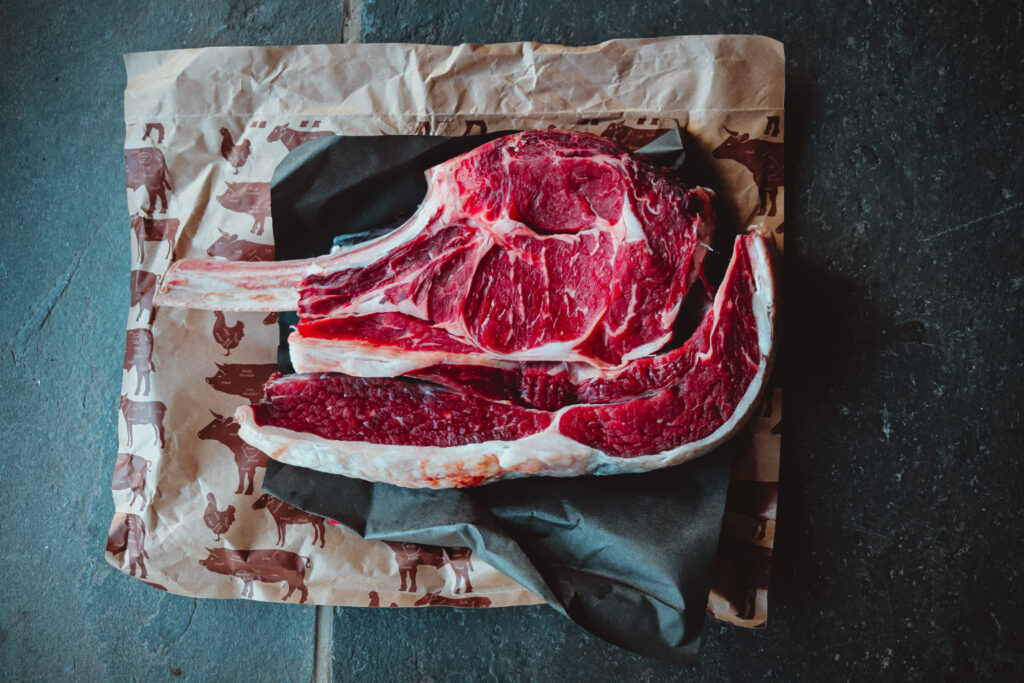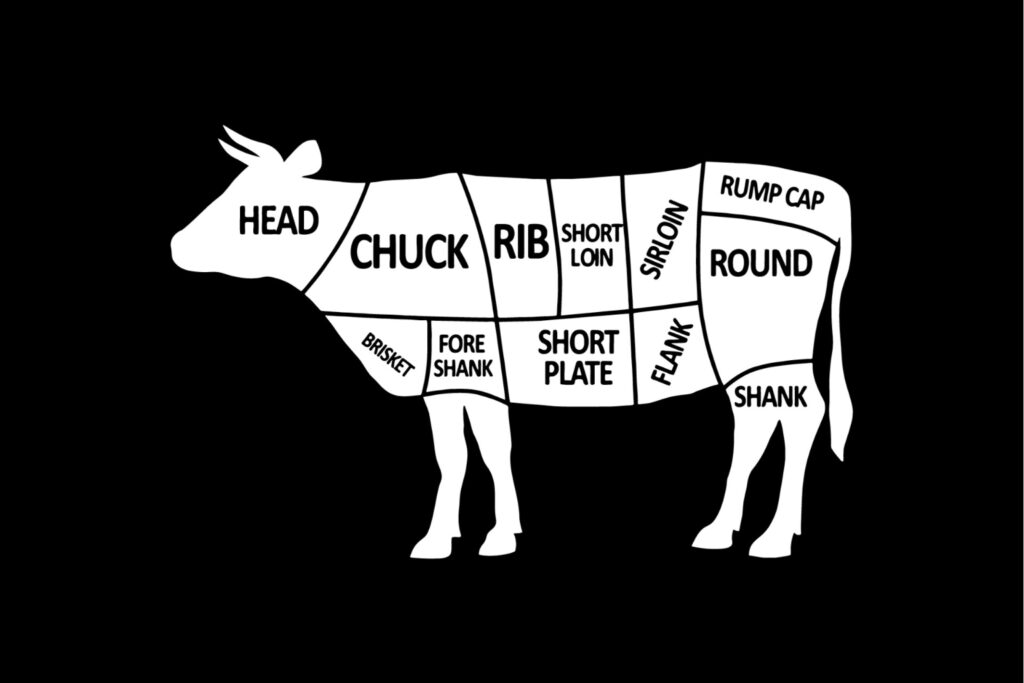
This is part one of five in our series on meat:
- Meat 101: Meat Basics (current page)
- Stay tuned for more posts in this series!
Health Disclaimer: Health and related lifestyle choices (including diets and dietary needs) are extremely individualistic. Please consult with your doctor before making any lifestyle changes.
Eating meat has been a long-standing tradition across many cultures throughout the world. From our hunter-gatherer days up to the present, various geographical locations and cultures have developed their own unique diets for preparing and consuming meat.
Our goal in this blog series is to provide you with basic information about the different parts of meat or cuts, relevant terms, as well as some animal-specific information so that you feel more confident when selecting meat at your local butcher shop or grocery store.

Parts & Pieces
There are many uses for all parts of an animal which are in turn used for different cuisines. Not all cultures will use every part of an animal, however, a surprising amount of the animal can be used.
Muscles
Muscle tissue is the red part of meat that most people envision when they think of meat. It is packed with iron, amino acids, and is considered a complete source of protein (meaning, it contains all nine amino acids that your body needs but cannot produce on its own.)
Generally speaking, the more work a muscle does, the tougher the meat will be. Therefore, muscles that are used less tend to be softer, more tender cuts of meat. We’ll cover this in more detail in future posts about specific animals.
Examples of Muscles: steak, sirloin, round, chuck, and brisket
Organs
In addition to high protein content, organs are nutrient-rich meats and often include many vitamins and minerals. Different organs will contain different amounts of vitamins and minerals. There is a wide range of delicacies made from specific organs.
Organ consumption tends to be more regional and culturally based in comparison to eating muscle tissue.
Examples of Organs: heart, liver, and tongue
Bone
Bones and marrow are packed with vitamins and minerals (ie calcium, magnesium, and phosphorus.) Although bones cannot be consumed directly, they can be steeped in hot liquids for long periods of time which brings out their nutrients and helps to flavor a dish. Making broth is one of the most common uses for bones which can then be used for making soups, sauces, and other recipes.
Examples of Cuts with Bones: T-bone steak, ribs, porterhouse, soup bones, and marrow bones
Fat
The amount of fatty tissue in meat varies widely by animal species as well as the quality and cut of the meat. The animal breed and diet greatly affect the amount of fat and flavor. For example, grass-fed animals tend to be leaner whereas grain-fed animals tend to have more fat.
Furthermore, fat is a good source of energy and helps to give meat its tenderness. As meat is cooked, the fat melts thereby making the cut juicier and more flavorful.
The term marbling refers to the fatty tissue that looks like white flecks and/or streaks across the muscle tissue. More marbling means more flavor and therefore, generally, better cuts of meat have more marbling.
Examples of Fat: At colder temperatures and room temperature, fat is solidified, white in color, and oily to the touch; when heated, fat will melt and turn into an oily clear liquid that floats on top of water and other juices.
Connective Tissues
Connective tissue attaches muscle to bone and is therefore a tougher type of tissue. Although connective tissues may be found on some cuts of meat, they are generally not commonly consumed in the US. However, in other parts of the world connective tissue is regularly used.
The most common connective tissue people will often mistake for fat is gristle. Gristle is considered an elastin which looks very similar to fat in color. Unlike fat, which is tender, and collagen which breaks down and softens when cooked, elastin is extremely chewy, rubbery, and very hard to break down.
Connective tissue has very little flavor which is another reason that it is less frequently used.
Examples of Connective Tissues: tendons, ligaments, collagen, elastin, or can be found anywhere that meat is connected to bone

Whole Cuts VS Processed Meats
It can be said that all meat is processed to some degree in order to turn the meat into edible portions. The act of butchering and making whole cuts is the simplest form of processing because it comes directly from the animal.
Moreover, grinding (turning meat into burger), mincing, or cutting raw meat in any way is considered partially-processed meat because it has been altered so little. More importantly, less processed meat does NOT contain any additives or preservatives. Butchered raw meat is the freshest, purest, and least processed form of meat you can purchase as a consumer.
Examples of partially-processed meats include:
- steaks and other whole cuts
- organs such as liver and heart
- ground burger
- uncooked and unseasoned brats
Fully-processed meats on the other hand are created by altering the meat from its natural form by smoking, salting, curing, fermenting, cooking, adding additional ingredients, or altering it in some way. The purpose of fully-processed meat is to enhance the flavor, improve preservation, and increase shelf life.
Fully-processed meats often include ready-to-eat products. Here are some examples of common fully-processed meats:
- sausage and lunch/deli meats
- corned beef
- ham and bacon
- jerky
- hot dogs
- canned meats and meat sauces
Prepackaged products found at the store will always have a label that shows the list of ingredients used which makes it easier to determine how the product has been seasoned or treated. That said, there is no formal labeling requirement to indicate whether a product is considered partially or fully-processed meat. It is up to the consumer to make an educated choice on what they are purchasing.
Recent studies have been published on health risks associated with consuming fully-processed meats. Depending on the ingredients used to cure and/or season fully-processed meats, various results have been documented that might affect your decision to consume these kinds of meats. Therefore, if you are looking for high-quality fresh meat, your best bet is to purchase raw butchered meat that has been minimally processed so that you can season and cook it yourself.
Furthermore, fresh raw meat can be found at your local butcher, in the grocery store meat department, and freezer section of the store. You should also consider that frozen raw meat may sometimes be the best bet for fresh meat because it is frozen directly after butchering. Any meats that are refrigerated have a shorter shelf-life in comparison to frozen so be sure that you check the sell-by date and consider when you plan to use the meat before purchasing.
Go to part two: Milk 102: Pasteurization & Homogenization ➡️
